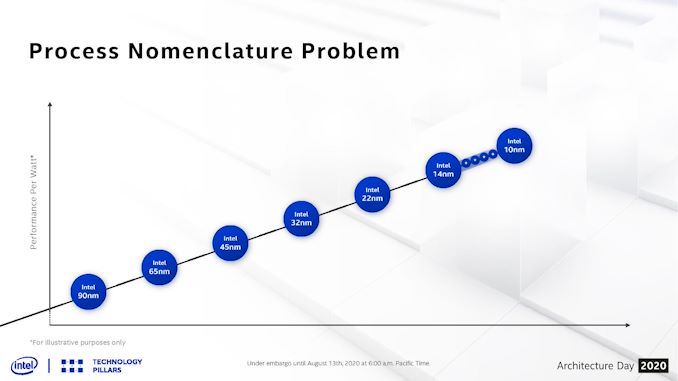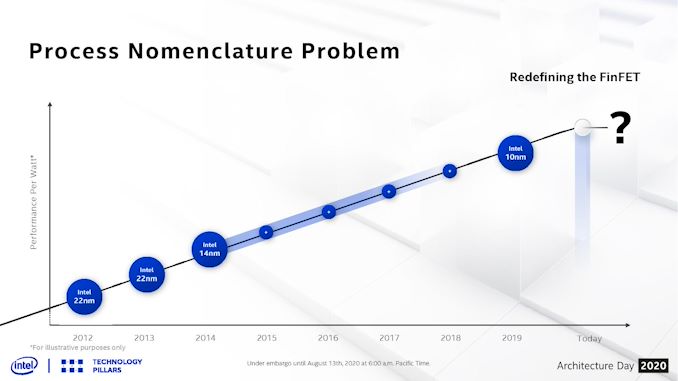What Products Use Intel 10nm? SuperFin and 10++ Demystified
by Dr. Ian Cutress on September 25, 2020 9:00 AM EST_678x452.jpg)
For our audience that regularly keeps track of Intel’s product portfolio, it would be hard to miss that the naming strategy of Intel’s process node technologies is a bit of a mess. To some, those words are themselves an understatement, as Intel has shifted its naming strategy 2-3 times since the launch of Intel’s first 10nm products. Not only that, even Intel’s various departments internally have a hard time keeping track of ‘what is this manufacturing process being called today’ when the press like AnandTech ask for details on the latest upcoming products.
Knowing this, and knowing what issues Intel has been having, I wanted to demystify Intel’s manufacturing process naming scheme such that users and engineers alike, even if they are inside Intel, can understand what is what but also importantly why. The why is the crucial factor.
If you're looking for a handy decoder ring for Intel's 10nm Products, it's here in page 3.
Why Do We Have Multiple Versions of a Process?
With Intel’s 14nm, we were invited to 14nm, 14+, 14++, 14+++, and if you believe Intel’s own slides, there were variants that went beyond this ++++ naming scheme. Each one of those additional + points on the end of the name signified a change in the process technology – usually to assist for increasing performance or efficiency.
Each one of these + points is an update to the BKM, or Best Known Methods.
While an engineer can draw an electrical layouts for a part of a processor, such as an addition circuit, actually applying that design to a silicon floorplan for manufacturing is a different skill altogether. Transistor libraries are designed to take advantage of a given process, and when a floorplan is optimized for a process, it can then be pasted and repeated as necessary – on top of this, simulation on thermals, power, and current density are applied to ensure that there are no hotspots or that critical paths inside the design have as few bottlenecks as possible.
When an update to the BKM occurs, two things can happen. Normally we see the update on the level of the transistor library that is changed – if the distance between two fins on a transistor increases for example, the transistor library and the macros may be made bigger, and then the floorplan might be redesigned to take account for this. As for any process node design, there are 100 different controls, and improving one might make three other controls worse, so it is a fine balancing act. Not only this, but the BKM has to be validated at the manufacturing level. The BKM update could apply to the metal stack as well, which in of itself can adjust the performance.
In the long long past, BKM updates were never advertised externally. If Intel or TSMC or another foundry discovered a way to improve the performance, or decrease the voltage, or improve the yield, the update was silently rolled into the design and nothing much was made of it. Sometimes processors would be listed as ‘1.0 volts to 1.35 volts’, and it would just be a roll of the dice if a user obtained one of the lower voltage models.
However, as time between different process node updates has elongated, these BKM updates have started to be identified and effectively monetized by the semiconductor companies. An update to a process that improves the voltage by 50 millivolts and increases frequency by 200 MHz immediately becomes a productizable event, and products built on these updates can be offered for more money over the usual. Or, depending on the rate of updates, the whole next generation of products could be built on the update.
So we never saw BKM updates officially announced at Intel’s 45nm, 32nm, or 22nm process nodes. These updates were fast enough that the productization of any update didn’t warrant a full round of marketing. With 14nm, that changed.
Intel had discussed its roadmap beyond 14nm since its 2010 Investor Meeting. It predicted that the company would be on 14nm by 2013, 10nm by 2015, and 7nm by 2017. As we now know, 14nm was two years late, and 10nm was 2-4 years late. Because of the introduction of 10nm being delayed, Intel decided to productize its 14nm BKM updates, and signified those with + points.
Intel’s current official line is that there have been four updates to 14nm, creating five ‘generations’.
More Plus Means More Meme
Because of all the + points, Intel’s marketing sometimes getting it wrong, and perhaps a little bit of ‘++’ in most programming languages meaning ‘+1’, the whole concept of adding + to the process node has become a meme – a meme at Intel’s expense, purely on the basis of its failure to deliver 10nm before the 14++++ naming scheme got out of hand.














143 Comments
View All Comments
AMDSuperFan - Friday, September 25, 2020 - link
All that matters is being able to multitask on as many things as possible. If I run a docker instance, that is one thing. If I use Cortana, which I very much enjoy using for my personal assistance, then that is a second thing. AMD is very good at releasing chips that do lots of things at once. It doesn't matter if they do each thing a lot slower as long as they can do many things. I am looking forward to all the games that can use hundreds of cores at once. Maybe a good chess game? Then AMD will be the best at chess games.dotjaz - Friday, September 25, 2020 - link
You won't be able to buy any consumer/prosumer CPU with beyond 128 cores in the next 10 years. Mark my words.I doubt 96-core CPU would be available anytime soon.
AMDSuperFan - Saturday, September 26, 2020 - link
AMD have proven that at any time they can release processors with many more slower cores than any other company. 200 or 400 cores will be no problem. Would you buy a processor that ran everything perfectly that was 10 cores or would you buy one with 400 cores just to say you are the best at doing most things slowly, but many things very fast? PKZIP will be no problem for the 400 core AMD chip while the competitors will be chugging away. The 200 core games will be very good.wumpus - Monday, September 28, 2020 - link
Once Intel cancels Xe, expect them to try again with a "x86 GPU". Presumably something like 96 Atom cores with AVX512 or something.And it will work just as well as every other time they tried it (for values of "they" which also include Sony thinking at first that cell could replace a GPU).
Putting 96 cores on a chip is one thing. Building the network fabric to hold it together is another. And supplying the I/O is the worst part. The only way this is happening is if you could stack the CPU on top of all the RAM, but that has mostly been given up.
ilkhan - Saturday, September 26, 2020 - link
Those things don't need an entire core to themselves. Having 8-16 cores is plenty for even a power user's desktop, until you get in serious multi threaded workloads, A/V editing/rendering, for example.Samus - Saturday, September 26, 2020 - link
95% of the consumer market doesn't want "200 cores to do 200 things" they want adequate performance to do basic things with 12+ hours of battery life, small footprint and a lot power bill.dotjaz - Friday, September 25, 2020 - link
Keep hallucinating. There won't be a consumer 32-core CPU any time soon, even for Threadripper which is intended for creator/prosumers 128-core isn't on the horizon anytime soon, let alone 200+ cores.Memory bandwidth, thermal and cost constraints simply won't allow it.
inighthawki - Friday, September 25, 2020 - link
>> There won't be a consumer 32-core CPU any time soon, even for ThreadripperThe 3970x is literally a 32 core variant of Threadripper.
JlHADJOE - Tuesday, October 6, 2020 - link
lol read his post again and realize you're quoting him the same way journalists quote Trump.Before the comma:
>> There won't be a consumer 32-core CPU any time soon
After the comma:
>> even for Threadripper which is intended for creator/prosumers 128-core isn't on the horizon anytime soon
Sure the sentence is a bit run-on, but he's clearly making a distinction between consumer which I assume is Ryzen, and prosumer which is Threadripper.
Spunjji - Friday, September 25, 2020 - link
Please, SOMEBODY, take this Turing Test-failing account offline.